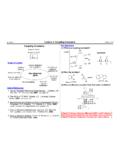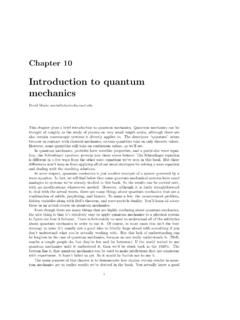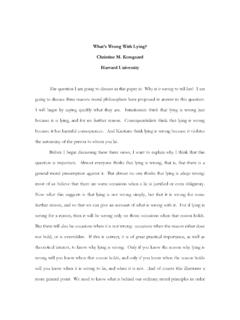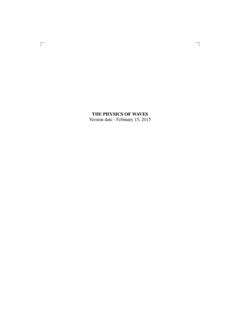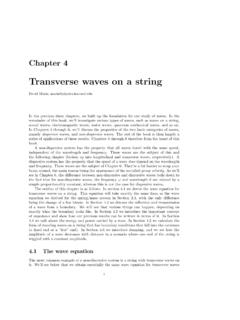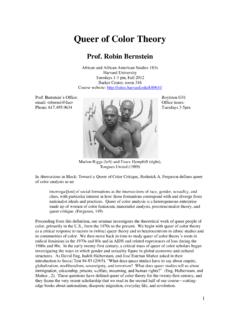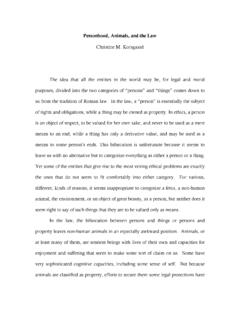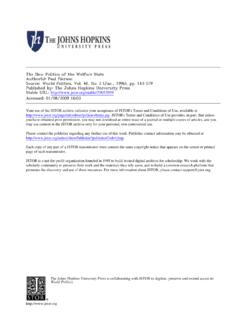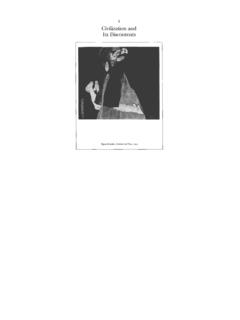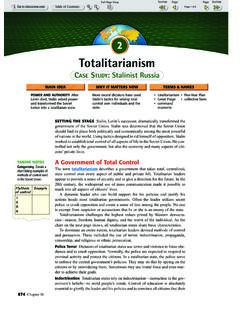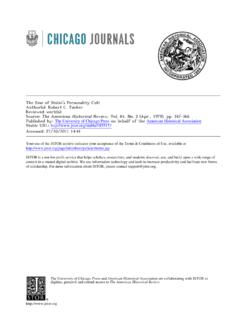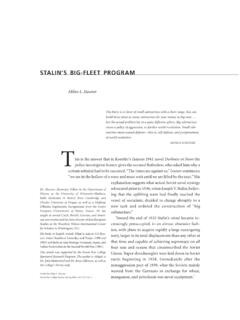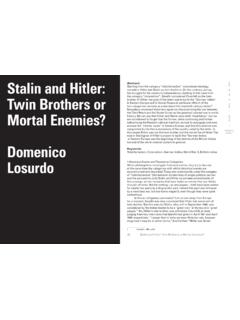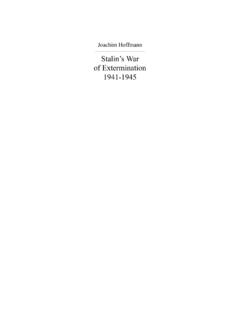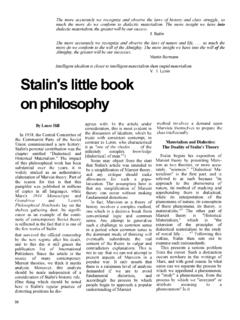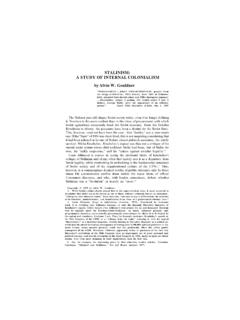Transcription of Stalin,Togliatti,and the Origins of the Cold War in Europe
1 3 PonsOrigins of the Cold War in EuropeStalin, togliatti , and the Origins of theCold War in Europe Silvio PonsAfter World War II Italy was included in the Western sphere ofin uence. There is no evidence that the Soviet Union tried to forestall thisoutcome. In the postwar peace process Moscow attached much lower priorityto Italy than to the East European countries that had been occupied by NaziGermany. Italy was of limited signi cance for Soviet foreign policy, and politi-cal and economic relations between the two countries never fully , at certain crucial junctures, Italy played a key role in the growingEast-West con ict over factors contributed to Italy s importance in the nascent Cold was the rst European country to be reoccupied by the Allied armies, and itwas therefore seen as an initial test of peacemaking and cooperation amongthe Allies. Soon after the coup d tat by King Vittorio Emanuele III againstMussolini on 25 July 1943 and the installation of a military governmentheaded by Marshal Pietro Badoglio, a secret armistice was concluded betweenItaly and the Allies on 3 September 1943.
2 The public announcement of thearmistice ve days later immediately divided the country into two parts:Northern Italy controlled by the Nazi German forces, which were supportingMussolini in his attempt to establish a fascist republic, and Southern Italycontrolled by British and American forces, which were supporting the monar-chy and Badoglio after their escape from Rome. At the Moscow Conferenceof October 1943, the United States, Great Britain, and the Soviet Unionagreed on a political and military framework for an armistice regime in Soviet Union was not given a role in the main administrative bodies in It-aly, and the British and Americans maintained tight control of the arrangement displeased Soviet leaders, who decided to counter whatthey saw as one-sided actions on the part of the Western governments. TheSoviet Union unilaterally reestablished diplomatic relations with Italy inJournal of Cold War StudiesVol. 3, No. 2, Spring 2001, pp. 3 27 2001 by the President and Fellows of Harvard College and the Massachusetts Instituteof TechnologyMarch 1944, a step that produced serious tension in Soviet relations withboth Britain and the United second factor that contributed to Italy s importance in the Cold Warwas the rapidly growing authority of the Italian Communist Party (PCI).
3 Inthe nal year of the war, Communist in uence spread throughout the coun-try. When the PCI leader, Palmiro togliatti , returned from Moscow in March1944, he abruptly changed the course of the PCI with his so-called Svoltadi Salerno, which called for cooperation with Badoglio to pursue a policy of national unity. This new approach t with Stalin s decision to recognizethe Badoglio government. During the fall and winter of 1943 1944, seriouscon ict had emerged between the antifascist parties (which banded togetherinto the National Liberation Committee, or CLN, created in Rome on9 September 1943) and the post-fascist institutions represented by the mon-archy and the Badoglio government. The CLN had adopted a rm anti-fascistposition (espoused by the Communists), opposing any collaboration withBadoglio and the king. With the Svolta di Salerno togliatti defused thiscon ict by suggesting that Italy s institutional future should be settled onlyafter the Germans and the Fascists had been defeated.
4 His stance initiallycame as a shock to the Communists and anti-fascists, but by May 1944 allof the parties in the CLN (with the exception of Partito d Azione) had enteredthe Badoglio government. In the meantime, at the beginning of 1944, thebasis for a mass anti-fascist resistance movement in Northern Italy was laidby the founding of the Northern CLN in Milan. Through the resist-ance movement the PCI became a mass party set to expand in postwar factor that bolstered Italy s role in Soviet calculations was thewidespread belief that Italy would dissolve into civil war as a consequence ofthe postwar turmoil and economic crisis and that this would lead to a series ofunpredictable events involving the major powers. Yugoslavia, the SovietUnion s most prominent ally in Europe , was pressing its geopolitical and revo-lutionary objectives in northeastern Italy at the end of the war and in the im-mediate postwar period. The rst crucial moment came in the winter andspring of 1945, when the CLN launched a nal insurrection against fascismto maintain the resistance movement s independence from British and The insurgents, however, refrained from using revolutionary rhetoric,since revolution seemed undesirable not only for the United States and Brit-ain, but also for Stalin (despite the ambitions of Yugoslav leader Josip BrozTito).
5 The second crucial moment came in the winter and early spring of1948, when the tense atmosphere before the April 1948 elections threatenedto end in violent con ict between the forces of the Popular Front (the coali-tion between Socialists and Communists) and the forces joined around the4 PonsChristian Democratic Party. Against the backdrop of the Cold War, in whichthe Italian antagonists were taking sides, the situation in 1948 was potentiallyeven more explosive than it had been in 1945. A combination of both domes-tic and international events the exclusion of the leftist forces from the gov-ernment in May 1947 after three years of participation in coalition govern-ments, the escalation of tensions between the Western powers and the USSR over the launching of the Marshall Plan, the founding of the Communist In-formation Bureau (Cominform) in 1947, and the Communist coup inCzechoslovakia in 1948 began to have a serious effect on Italy. The erceclash between the opposing sides in the electoral campaign generated uncer-tainty and apprehension in the international community.
6 Only the landslidevictory of the Christian Democratic Party, achieved with the crucial supportof the Catholic Church and nancial aid from the United States, stabilizedthe Italian situation. Divisions in society continued for some time, and theybrie y became explosive after the attempt on togliatti s life in July 1948brought the country to the brink of civil war once Italy was not a primary concern for Soviet foreign policy, it still couldnot be ignored entirely. For this reason, relations between the Soviet Unionand the PCI can be seen as a case study of Soviet foreign policy and the originsof the Cold available archival material demonstrates that thetight link between Moscow and the West European Communist parties re-quired the parties to subordinate their interests to those of the Soviet does not mean that historians are correct either to assume a uniform So-viet approach to West European Communism or to present Soviet policy atthe end of the Second World War as a compact strategy aimed at the revolu-tionary conquest and Bolshevization of the Italian case, manyscholars have depicted Soviet-PCI relations as a one-way command structure,in which the Soviet Union made all the decisions and the PCI ignores substantial evidence of the complexity of Soviet strategytoward Europe .
7 Stalin s postwar policy never seemed directed at installingCommunist regimes in Western Europe . As some historians have observed, hepreferred a divided and docile Europe , rather than a Communist one. 4 For5 Origins of the Cold War in Europe1. For a detailed analysis of the years 1943 to 1948, see Silvio Pons,L impossibile egemonia. L Urss, il Pcie le origini della guerra fredda (1943 1948)(Rome: Carocci, 1999).2. See R. C. Raack,Stalin s Drive to the West 1938 1945: The Origins of the Cold War(Stanford, CA:Stanford University Press, 1995). See also Douglas J. Macdonald, Communist Bloc Expansion in theEarly Cold War: Challenging Realism, Refuting Revisionism, International Security,Vol. 20, No. 3(Winter 1995/96), pp. 152 Elena Aga-Rossi and Victor Zaslavsky, togliatti e Stalin. Il Pci e la politica estera staliniana negliarchivi di Mosca(Bologna: Il Mulino, 1997).4. Vojtech Mastny,The Cold War and Soviet Insecurity: The Stalin Years(Oxford: Oxford UniversityPress, 1996), p.
8 Reasons, the relationship between the Soviet Union and the EuropeanCommunist parties was often contradictory and Foreign Policy and Italy: An UndefinedStrategySoviet leaders began to formulate their policy toward Italy during the MoscowConference of October 1943, when the great powers had to arrive at a com-mon position on the Italian question. The conference was held only a fewweeks after the Badoglio government signed a truce. For Soviet of cials, atradeoff emerged between their desire to offset Western in uence and theirhesitation about working with the institutions that emerged in Italy after thedownfall of the Fascists. Documentary sources reveal that different views ex-isted in Moscow about how to deal with this tradeoff. In a letter written ashort while before the Moscow Conference to Georgi Dimitrov, the of cialresponsible for Soviet ties with foreign Communist parties, togliatti identi- ed isolation as the main danger facing Communists and did not mention theproblem of the king s abdication, thus suggesting the adoption of a moderateapproach toward the Badoglio s proposal was notre ected in the initial stance of the Soviet People s Commissariat on ForeignAffairs (Narkomindel).
9 On 18 October 1943 the Soviet foreign minister,Vyacheslav Molotov, sent Stalin a memorandum rejecting Britain s suggestionto link the recognition of the Badoglio government with the application ofthe co-belligerent nation formula to the Conference, however,Soviet leaders suggested only re-organizing not liquidating the these differing views on policy toward Italy, Sovietstrategy seemed to be leaning toward exible diplomacy that would verify the6 Pons5. Letter from togliatti to Dimitrov, 14 October 1943, Rossiiskii Gosudarstvennyi Arkhiv Sotsialno-Politicheskoi Istorii (RGASPI), Fond (F.) 495, Opis (Op.) 74, Delo (D.) 256, Listy (Ll.) 45 47. Seealso Francesca Gori and Silvio Pons, eds.,Dagli archivi di Mosca. L Urss, il Cominform e il Pci,Fondazione Istituto Gramsci,Annali,Vol. 7 (Rome: Carocci, 1998), doc. 4. As early as a few monthsbefore, immediately after the fall of Fascism in Italy in July 1943, togliatti had sent Dimitrov two let-ters that advanced moderate proposals.
10 The letters had supported the formation of a government ofbroad alliances and a future convocation of a Constituent Assembly, but they required the king to ab-dicate. Letters from togliatti to Dimitrov, 27 July, 30 July, and 14 October 1943, RGASPI, F. 495,Op. 74, D. 256, Ll. 35, 35 ob., 39 40. See also Gori and Pons, eds.,Dagli archivi di Mosca,docs. 1, 2, Memoradum, Molotov to Stalin, 18 October 1943, Arkhiv Vneshnei Politiki Rossiiskoi Federatsii(AVPRF), F. 06, Op. 5b, Papka (Pap.) 39, D. 6, L. Memorandum from Molotov to Stalin, 18 October 1943, AVPRF, F. 07, Op. 4, Pap. 30, D. 37, of the Advisory Council on Italy, which had been established atthe Moscow Conference. togliatti also seemed to favor this approach, whichwould have steered the PCI toward collaboration with the ruling , archival documents show that in the months following the Confer-ence, Soviet and Communist policy makers continued to waver between dif-ferent Soviet strategy formulated at the Moscow Conference was mostlyabandoned in the wake of Andrei Vyshinskii s frustrating experience as the So-viet representative in the Italian Advisory Council.

